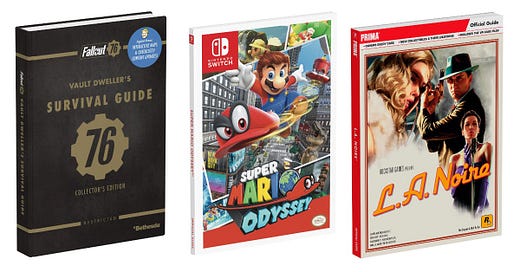With the rise of the internet these days you don’t tend to see many physical guides anymore but when I was younger most major releases had a guide you could buy. With websites like GameFAQs and many media outlets information that was typically found in guides being provided for free online the need for physical book guides has dwindled entirely. Furthermore, games generally guide you through the game a lot more than they used to so even needing to find a guide is more reserved for completionism or being stuck on a puzzle for the most part. More on this later.
The last generation or so of gaming has a lot of DLC practices and a lot of them are predatory such as pre-order DLC that is only an unlock code of something that was included in the game anyway. Ultimately though DLC is a way of extracting additional money from players who are probably quite committed to the game already.
So how do physical guides and DLC relate to each other? It’s because they were both designed to extract extra money from the player. From what I remember as a child, guides were typically around the £10-15 range. A lot of DLCs also cost similarly too, some are higher and some are a lot lower.
Too often as well guides felt like an essential purchase. I still have quite a few of them. I have the guide for Skyward Sword, Final Fantasy VII-X and XV, Golden Sun and Golden Sun The Lost Age to list a few of them. What all these games have in common except for being JRPGs or JRPGs adjacent is that they all have complicated puzzles or many different secrets that the average player just wouldn’t be able to find or complete easily.
Games were seemingly designed to be deliberately convoluted to entice gamers to purchase these guides in a similar way to pay-to-win mechanics seen in modern games. I remember for example hearing about how difficult the Water Temple is in Ocarina Of Time, how the 3DS version fixed a lot of its issues and people using guides for that section. I know from my own experience that in Final Fantasy there used to be many hidden summons that often relied on players having certain items or abilities to get them and they were the best summon monsters in the game.
One of the more famous examples is getting the summon Knights of the Round in Final Fantasy VII. To get them, you had to go to a specific hidden island that you wouldn’t have gone to otherwise in the game. To add a layer of complexity to it, to reach the island the player needed a Gold Chocobo.
To get a Gold Chocobo, the player had to breed them. However, it wasn’t a case of just breeding a Gold Chocobo, the player first had to breed black, green and blue chocobos. To add to the complexity the player had to give the chocobos specific nuts to breed the right colour to progress. To get the first coloured chocobo as well, you had to capture normal chocobos from specific areas with a specific quality ranking too. All of this was not clearly explained in the game as the game only told you how to breed chocobos and left the rest up to you.
I remember Playing Final Fantasy X and being blown away when I first saw Anima who to this day remains my favourite summon monster in the series. I remember wanting that summon badly but finished the game without it because I didn’t think I could get it. I eventually found out I could and naturally bought the guide to teach me how and was gobsmacked that the game didn’t make it clear as to what the method was. It turns out that each of the temples in the game had a secret item that the player needed to get before attempting to get Anima. The problem was however that in the UK version of the game, you couldn’t go back to some of the temples without fighting a Dark Aeon who you could only really defeat once you had gotten every ability and ultimate weapon in the game first. None of this was clear without the guide.
In some ways older game mechanics could be quite toxic and predatory in the same way DLC is today but even if it was difficult for the average player to find everything, it was ultimately achievable for everyone. Everything was on the disc or cartridge, it was just up to the player to try and think like the developer and find them.
DLC however is such a broad term as it can include pay-to-win microtransactions, cosmetics, levels/maps, additional characters and so much more. When it boils down to it, both ultimately allow publishers to extract more money out of players and so I believe that the idea behind physical guides is similar to DLC. Let me know what you think in the comments below and if you have a moment, please consider following us on here and Twitter/Mastodon.



